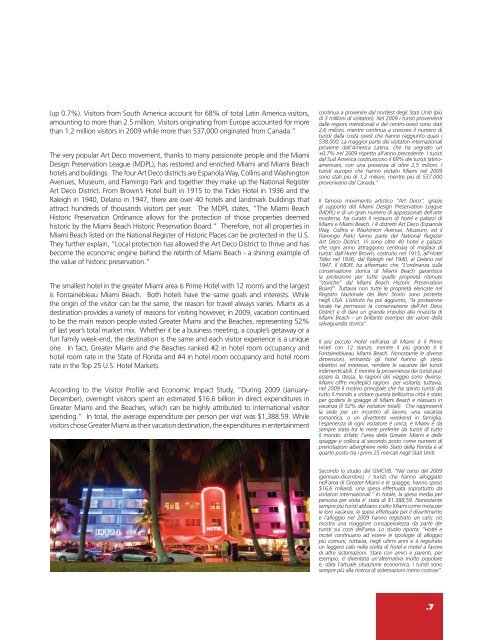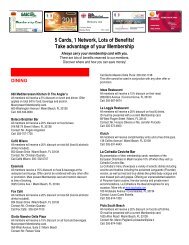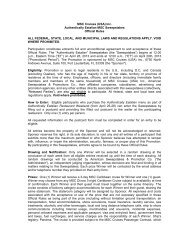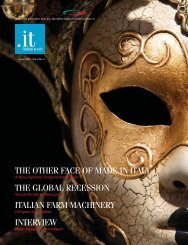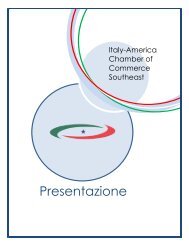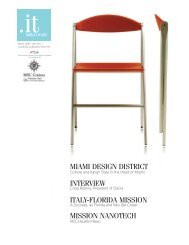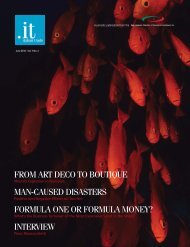interview - Italy-America Chamber of Commerce, Southeast
interview - Italy-America Chamber of Commerce, Southeast
interview - Italy-America Chamber of Commerce, Southeast
Create successful ePaper yourself
Turn your PDF publications into a flip-book with our unique Google optimized e-Paper software.
(up 0.7%). Visitors from South <strong>America</strong> account for 68% <strong>of</strong> total Latin <strong>America</strong> visitors,<br />
amounting to more than 2.5 million. Visitors originating from Europe accounted for more<br />
than 1.2 million visitors in 2009 while more than 537,000 originated from Canada.”<br />
The very popular Art Deco movement, thanks to many passionate people and the Miami<br />
Design Preservation League (MDPL), has restored and enriched Miami and Miami Beach<br />
hotels and buildings. The four Art Deco districts are Espanola Way, Collins and Washington<br />
Avenues, Museum, and Flamingo Park and together they make up the National Register<br />
Art Deco District. From Brown’s Hotel built in 1915 to the Tides Hotel in 1936 and the<br />
Raleigh in 1940, Delano in 1947, there are over 40 hotels and landmark buildings that<br />
attract hundreds <strong>of</strong> thousands visitors per year. The MDPL states, “The Miami Beach<br />
Historic Preservation Ordinance allows for the protection <strong>of</strong> those properties deemed<br />
historic by the Miami Beach Historic Preservation Board.” Therefore, not all properties in<br />
Miami Beach listed on the National Register <strong>of</strong> Historic Places can be protected in the U.S.<br />
They further explain, “Local protection has allowed the Art Deco District to thrive and has<br />
become the economic engine behind the rebirth <strong>of</strong> Miami Beach - a shining example <strong>of</strong><br />
the value <strong>of</strong> historic preservation.”<br />
The smallest hotel in the greater Miami area is Prime Hotel with 12 rooms and the largest<br />
is Fontainebleau Miami Beach. Both hotels have the same goals and interests. While<br />
the origin <strong>of</strong> the visitor can be the same, the reason for travel always varies. Miami as a<br />
destination provides a variety <strong>of</strong> reasons for visiting however, in 2009, vacation continued<br />
to be the main reason people visited Greater Miami and the Beaches, representing 52%<br />
<strong>of</strong> last year’s total market mix. Whether it be a business meeting, a couple’s getaway or a<br />
fun family week-end, the destination is the same and each visitor experience is a unique<br />
one. In fact, Greater Miami and the Beaches ranked #2 in hotel room occupancy and<br />
hotel room rate in the State <strong>of</strong> Florida and #4 in hotel room occupancy and hotel room<br />
rate in the Top 25 U.S. Hotel Markets.<br />
According to the Visitor Pr<strong>of</strong>ile and Economic Impact Study, “During 2009 (January-<br />
December), overnight visitors spent an estimated $16.6 billion in direct expenditures in<br />
Greater Miami and the Beaches, which can be highly attributed to international visitor<br />
spending.” In total, the average expenditure per person per visit was $1,388.59. While<br />
visitors chose Greater Miami as their vacation destination, the expenditures in entertainment<br />
continua a provenire dal nordest degli Stati Uniti (piú<br />
di 3 millioni di visitatori). Nel 2009 i turisti provenienti<br />
dalle regioni meridionali e del centro-ovest sono stati<br />
2,6 milioni, mentre continua a crescere il numero di<br />
turisti dalla costa ovest che hanno raggiunto quasi i<br />
538.000. La maggior parte dei visitatori internazionali<br />
proviene dall’<strong>America</strong> Latina, che ha segnato un<br />
+0,7% nel 2009 rispetto all’anno precedente. I turisti<br />
dal Sud <strong>America</strong> costituiscono il 68% dei turisti latinoamericani,<br />
con una presenza di oltre 2,5 milioni. I<br />
turisti europei che hanno visitato Miami nel 2009<br />
sono stati piú di 1,2 milioni, mentre piú di 537.000<br />
provenivano dal Canada.”<br />
Il famoso movimento artistico “Art Deco”, grazie<br />
al supporto del Miami Design Preservation League<br />
(MDPL) e di un gran numero di appassionati dell’arte<br />
moderna, ha curato il restauro di hotel e palazzi di<br />
Miami e Miami Beach. I 4 distretti Art Deco (Espanola<br />
Way, Collins e Washinton Avenue, Museum, ed il<br />
Flamingo Park) fanno parte del National Register<br />
Art Deco District. Vi sono oltre 40 hotel e palazzi<br />
che ogni anno attraggono centinaia di migliaia di<br />
turisti: dall’Hotel Brown, costruito nel 1915, all’Hotel<br />
Tides nel 1936, dal Raleigh nel 1940, al Delano nel<br />
1947. Il MDPL ha affermato che “L’ordinanza sulla<br />
conservazione storica di Miami Beach garantisce<br />
la protezione per tutte quelle proprietá ritenute<br />
“storiche” dal Miami Beach Historic Preservation<br />
Board”. Tuttavia non tutte le proprietá elencate nel<br />
Registro Nazionale dei Beni Storici sono protette<br />
negli USA. L’istituto ha poi aggiunto, “la protezione<br />
locale ha permesso la conservazione dell’Art Deco<br />
District e di dare un grande impulso alla rinascita di<br />
Miami Beach - un brillante esempio del valore della<br />
salvaguardia storica”.<br />
Il piú piccolo Hotel nell’area di Miami é il Prime<br />
Hotel con 12 stanze, mentre il piú grande é Il<br />
Fontaineblueau Miami Beach. Nonostante le diverse<br />
dimensioni, entrambi gli hotel hanno gli stessi<br />
obiettivi ed interesse, rendere le vacanze dei turisti<br />
indimenticabili. E mentre la provenienza dei turisti puó<br />
essere la stessa, le ragioni del viaggio sono diverse.<br />
Miami <strong>of</strong>fre molteplici ragioni per visitarla; tuttavia,<br />
nel 2009 il motivo principale che ha spinto turisti da<br />
tutto il mondo a visitare questa bellissima cittá é stato<br />
per godersi le spiagge di Miami Beach e rilassarsi in<br />
vacanza (il 52% dei visitatori totali). Che rappresenti<br />
la sede per un incontro di lavoro, una vacanza<br />
romantica, o un divertente weekend in famiglia,<br />
l’esperienza di ogni visitatore é unica, e Miami é da<br />
sempre stata tra le mete preferite da turisti di tutto<br />
il mondo. Infatti, l’area della Greater Miami e delle<br />
spiagge si colloca al secondo posto come numero di<br />
prenotazioni alberghiere nello Stato della Florida e al<br />
quarto posto tra i primi 25 mercati negli Stati Uniti.<br />
Secondo lo studio del GMCVB, “Nel corso del 2009<br />
(gennaio-dicembre), i turisti che hanno alloggiato<br />
nell’area di Greater Miami e le spiagge, hanno speso<br />
$16,6 miliardi, una spesa effettuata soprattutto da<br />
visitatori internazionali.” In totale, la spesa media per<br />
persona per visita é’ stata di $1.388,59. Nonostante<br />
sempre piú turisti abbiano scelto Miami come meta per<br />
le loro vacanze, le spese effettuate per il divertimento<br />
e l’alloggio nel 2009 hanno registrato un calo; ció<br />
mostra una maggiore consapevolezza da parte dei<br />
turisti sui costi dell’area. Lo studio riporta: “Hotel e<br />
motel continuano ad essere le tipologie di alloggio<br />
piú comuni; tuttavia, negli ultimi anni si é registrato<br />
un leggero calo nella scelta di hotel e motel a favore<br />
di altre sistemazioni. Stare con amici e parenti, per<br />
esempio, é diventata un’alternativa molto popolare<br />
e, data l’attuale situazione economica, i turisti sono<br />
sempre piú alla ricerca di sistemazioni meno costose”.<br />
.7


